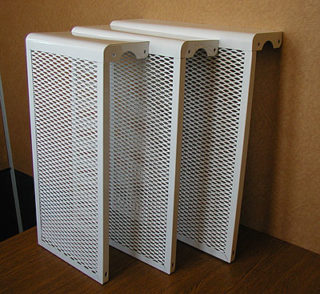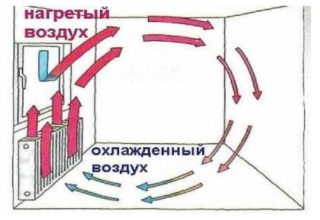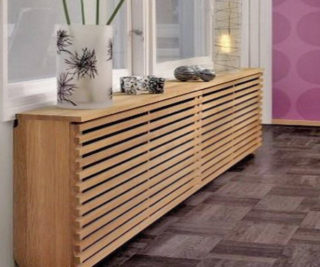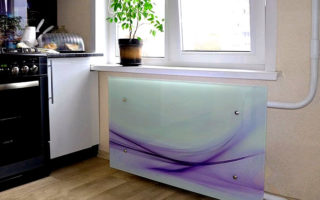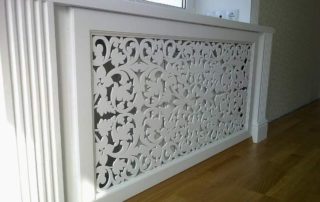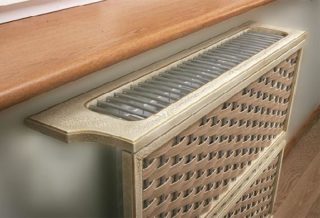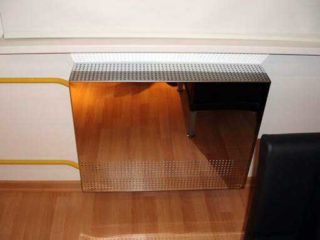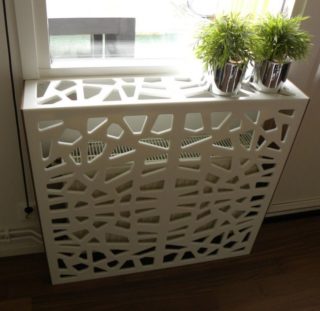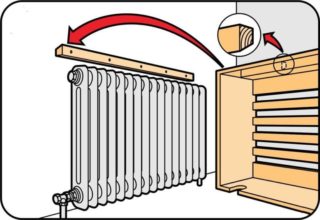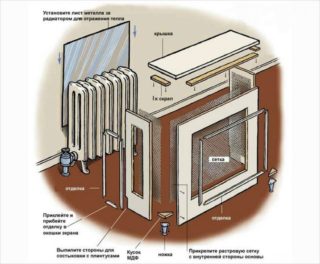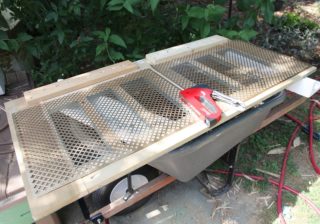Heating batteries do not always have an aesthetic appearance. This is especially true for old massive products that can no longer be restored. To hide the radiators, special decorative grilles are used. They come in different types, styles, colors and are designed for a different budget.
The principle of heat supply
Decor is the primary function of battery grilles. But radiators are used to heat the home, so there should be no obstacles in the way. Even the thinnest screens reduce heat transfer, so you should pre-select products with a small percentage of absorbed heat.
Air should enter the radiator from below, pass along it, heat up and go up. According to such a system, the room will be heated. Therefore, when choosing a battery grill, you need to ensure that there is a small gap at the bottom, and there is no cover at the top. It is possible that the top cover has a large perforation area.
Many modern decorative radiator grilles reduce heat transfer by more than 20%. Especially a large percentage of heat is lost in the form of boxes made of solid wood. Models with a minimum number of holes and a small perforation area will be ineffective in operation.
The screen additionally protects the radiator from dirt. Dust particles settle on a hot battery and decompose under the influence of high temperature. As a result, the surrounding atmosphere is polluted by decomposition products, which is harmful to human health, especially for allergy sufferers and asthmatics. When installing the grill, dust settling on radiators is significantly reduced. Periodically, you need to clean the screen with a rag or vacuum cleaner.
Objectives and materials of gratings
In addition to the decorative function, the grilles perform a protective task. They allow you to hide and round sharp and hard edges. This is especially true if there are small children in the house who may be injured. The screens on the heating radiator also do not give the opportunity to get burned on hot pipes.
Screens are made of the following materials:
- Metal. One of the most popular screen materials for heating batteries. They are made of thin steel, which is then painted. The duration of operation depends on the quality of the color. They are considered the most optimal, since they practically do not give heat losses. The metal heats up quickly and emits heat itself, so the room will not be cold. The advantages include a long working time, which reaches several decades, as well as low cost. The disadvantage is not the most aesthetic appearance. There are forged models, but they need a background.
- Wood. Wood is an extra class material. It is environmentally friendly, looks stylish and allows you to create lattices of various shapes. Even inexpensive wood models look beautiful. But battery performance behind a wooden screen is greatly reduced. It takes a lot of time to heat wood.
- Plastic. For the bathroom and the bathroom, the use of plastic screens is optimal. The material is distinguished by its hygiene, durability and ease of care. To keep the plastic grill clean, just rinse it. For battery screens, heat-resistant plastic is used that can withstand heat up to 60-80 ° C.
- Glass. Such material is rarely used due to imperfections in terms of heating function.They look stylish and beautiful and fit any home interior. They are made of tempered glass, which is then matted or painted. It differs in quality and reliability, as it is made from durable types of material.
- PVC Screens from this material can be made both on a metal base, and on a PVC frame or with rattan inserts. It features a wide variety of designs. There are models for wood, marble, stone cut, metal. The thermal conductivity of PVC is lower than that of metal and wood, so more fuel will be needed to heat the home. The material is characterized by heat resistance, durability, lack of emission of harmful and toxic substances when heated. Have an affordable cost.
- MDF. Wooden models are very expensive, so many replace them with analogues from MDF. This material is also environmentally friendly and stylish, and the average price is 1000-1500 rubles per unit. The product may not be completely made of MDF - for example, there may be inserts made of metal or wood. The grate tolerates temperature jumps, high humidity and other negative external factors without visible deformations. Of the negative qualities, one can single out a large weight and the complexity of removing the system.
You can find grilles on radiators made of exotic materials - these include bamboo and rattan. They perform only a decorative role and do not fit into every interior, so they are rarely used. On sale there are also combined models. A classic example is a wooden frame, on which a decorative mesh made of another material is stretched (bamboo, panels made of MDF and HDF).
Advantages and disadvantages of different materials
Wooden models have the following positive qualities:
- Durability. With proper use, the tree practically does not lose its properties.
- Reliability.
- Environmental friendliness. Wood is a natural material that does not emit harmful substances.
- High degree of heat transfer.
The main disadvantages:
- Volumetric wooden lattices do not withstand temperature surges. Some models may crack after a few seasons.
- Duration of heating the tree.
Glass screens are used infrequently. But they have the following advantages:
- The price is lower than wood.
- Ease of installation. Install the grille can any master.
- Stylish appearance. On the screen you can apply drawings and photographs by thermal printing for any interior.
- Safety, ease of maintenance, high degree of heat resistance.
The disadvantages of glass models include fragility. Cheap items can be made of thin glass, which is why they can be accidentally broken. High-quality expensive screens are made of durable material, which is almost impossible to damage.
The advantages of plastic models are as follows:
- Attractive value. You can find a screen for a radiator for any budget.
- A wide range of. There are shapes and colors suitable for any interior.
- Ease of care. Plastic products can be washed an unlimited number of times.
Disadvantages:
- They quickly lose their attractive appearance.
- When heated, harmful substances may be released. They can negatively affect people's health. Such models are not allowed to be installed in medical institutions, kindergartens and schools.
Pluses of metal models:
- Practicality. Screens are unpretentious and can be installed in any conditions.
- Resistance to temperature jumps.
- Strength.Metal practically does not give in to mechanical influences and vibrations.
- Metal gratings are not affected by changes in pressure and humidity.
- Easy installation. They are also easy to dismantle.
- Low cost. It is connected with the simplicity of manufacturing technology.
- Duration of operation. It is associated with the unpretentiousness of the material and the lack of reaction to external influences.
- A wide selection of models. They are presented in all price ranges.
The disadvantages of metal include the difficulty of self-manufacturing. In this case, it is better to buy a finished model or order according to individual sizes and characteristics.
The remaining materials are practically not used.
Varieties of screens
The classification of grilles for heating radiators is also carried out by design. Each type is used for its own type of battery and is designed for different installation methods.
Flat screens are used if the radiator is mounted in a niche. Then the flat panel is fixed on the bars, which are attached around the perimeter of the niche. Similarly, glass grids are mounted on special pins. These types of screens are called "facades."
There are two types of mounted grilles - with a lid in the upper part and without it. The first are placed on the batteries of the "accordion" type, which protrude beyond the windowsill. The shape of the top cover is made so that the grill can be fixed on the radiator. Products without a cover are attached to the upper radiator header by hooks, which are fixed on the front panel.
Boxes are used infrequently due to the large percentage of heat loss. Air circulation in such models is difficult. Necessary if you want to close the sides of the battery. According to the method of fixation, they secrete boxes that can stand without support on special legs, and requiring mounting on the wall.
Fixation Features
The main requirement for grilles on radiators is the ability to quickly access heating appliances and pipes. This is due to the need for periodic cleaning of heating elements from dust and dirt. It is recommended to clean twice a year. Emergencies also occur in which the master should have easy access to the failed section. It is important to think over such a fixing system in advance, so that without difficulties you can remove the screen if necessary.
Hinged and attached screens comply with this requirement. They are removed in a few seconds and just as quickly installed. Problems arise with flat and closing radiators, as well as ducts. Such models are recommended to be fixed to the wall on two slats - one on the box and one on the wall. The top face should be beveled towards the grate. When installing the grill, this part acts as a lock, which is easy to remove if necessary.
There is another installation option. Metal elements (for example, plates) can be placed on one bar, and magnets on another. Then there will be no problems with the removal and installation of gratings.
Flat screens can be fixed on hooks or loops. Making them is simple, but it can be difficult to install with a loop. Sometimes they put a decorative version of lattices with sliding doors.
Self-made lattice
Stores offer a huge assortment of screens made of different materials, with various shapes, designs and colors. But if you wish, you can independently make a decorative lattice with your own hands. The work is simple, all the necessary materials can be bought at any hardware store. Professional equipment is not required.
To create a screen on the battery, you need the following tool:
- Lattice material. MDF or particleboard is usually used, since it is easiest to work with.
- Hacksaw.
- Construction glue.
- Sheet steel mesh for the front and sides.
- Metal sheet for reflector.
- Nails, screws, locks.
- Roulette, pencil.
The first step is the measurement. It is necessary to measure the height and width of the radiator. For each value obtained, add 1
0 cm. A little less than 5 cm can be added to the height. Next, the battery depth is measured, and 2.5 cm is added to its size. The size of the future cover is measured in the same way. Its final dimensions should exceed the size of the sidewalls by 2-3 cm.
Cutting parts. The front part is created from sheets of MDF or particleboard. Rectangular details with a width of about 11 cm are cut from them. In the contact areas, angles of 45 ° should be made for ease of connection.
A metal reflector is mounted on the back. The dimensions should be approximately the same as that of the decorative cover. It allows you to reduce heat loss and direct infrared waves to the center of the room.
Next, put a steel sheet mesh. It serves as a frame, which then collects all previously cut elements.
After the grill is assembled, you can install it on the battery.
If there is no way to make a screen yourself, you can place an order for individual sizes.
